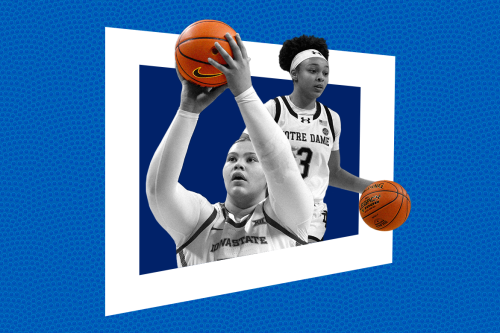Our editors independently select these products. Making a purchase through our links may earn Well+Good a commission
In 2019, Eliud Kipchoge became the first runner to complete a marathon in under two hours. One key factor attributed to his success: his shoes. Kipchoge was wearing a Nike prototype sneaker not yet available to the public. But next year, shoe technology that was once reserved for making the world’s top athletes perform harder, better, faster, stronger will be available to all of us at the click of a button.
The global sneaker industry is on track to hit $97.8 billion in four years—and that’s primarily due to innovations that are already well underway. “It’s not just performance athletes who are benefiting,” says Danny Orr, general manager for performance running at New Balance. “We really are seeing everyday runners being able to run farther, being able to run faster, being able to run more frequently.”
One shoe upgrade that’s now trickling down to the everyday fitness enthusiast is carbon-fiber plating in the footbed, which helps to propel runners forward in these fast running shoes, making every step more energy-efficient. By Nike’s measure, adding this component to shoes boosts runners’ speeds by 4 percent. “Now that consumers have access to this innovation [with the Air Zoom Alphafly NEXT%], we’ve heard from many that they’re running their fastest times ever,” says Jenna Golden, director of Nike media relations and narrative. Nike isn’t the only brand using carbon fiber plates: This fall, Brooks launched the Hyperion Elite 2, an ultra-fast shoe with plates built from a prototype that helped Des Linden win the Boston Marathon in 2018. The just-launched, ultra-high-end Courser sneaker utilizes the technology, as does On Cloudboom Shoes to keep the wearer’s feet in the optimum position to hit the pavement.
Another high-tech feature that will become more available to the public next year is lightweight, energy-transferring foam that helps with speed and cushion (over the thousands of steps on your run, a heavy shoe can slow your pace and wear down your joints). “Materials that are lighter weight, more durable, bouncier will extend themselves farther across [sneaker] categories” in 2021, says Jean-Luc Diard, founder of Hoka One One. Asics will release the latest iteration of its MetaRacer, which contains FlyteFoam technology that helps feet to bounce back after striking the pavement. And New Balance has plans to extend the FuelCell line, which has advanced foams that give runners a lot more bounce back.
When it comes to these two big upgrades, the name of the game is efficiency and injury prevention. “The technological advances have helped our foot structure, our form, our biomechanics, and the health of our body,” says Jordan Marie Daniel, founder of Rising Hearts and professional runner with Altra and RabbitPRO.
And while Daniel is an elite runner, everyone who laces up can benefit from these advances. “These technologies are for everybody,” says Orr. “The people who want to use them to run faster can really enjoy them, but the benefits also exist for that person who wants to be able to get out a little bit more frequently.” In 2021, we might not be breaking World Records, but with the help of smarter shoe tech, we’ll definitely be breaking our own.
Shop high-tech performance running sneakers
1. Saucony Women’s Endorphin Pro, $200
Shop now: Saucony Women’s Endorphin Pro, $200
2. New Balance FuelCell RC Elite, $224
Shop now: New Balance FuelCell RC Elite, $224
3. Nike Air Zoom Tempo NEXT%, $200
Shop now: Nike Air Zoom Tempo NEXT%, $200
4. Brooks Hyperion Tempo, $150
Shop now: Brooks Hyperion Tempo, $150
5. On Cloudflyer, $159
Shop now: On Cloudflyer, $159Explore the rest of our 2021 Wellness Trends.
Sign Up for Our Daily Newsletter
Get all the latest in wellness, trends, food, fitness, beauty, and more delivered right to your inbox.
Got it, you've been added to our email list.
















